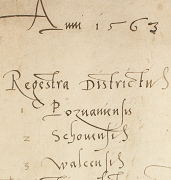Atlas historyczny Polski. Rejestry poborowe województwa poznańskiego w XVI w., red. M. Słoń, Instytut Historii im. Tadeusza Manteuffla PAN,2015 jest dostępne na licencji:
Creative Commons Attribution-NoDerivatives 4.0 International (treść)
Atlas historyczny Polski. Rejestry poborowe województwa poznańskiego w XVI w., red. M. Słoń, Instytut Historii im. Tadeusza Manteuffla PAN,2015 jest dostępne na licencji:
Creative Commons Attribution 4.0 International (dane)
Niniejsza edycja zawiera prezentację rejestrów poborowych województwa poznańskiego z drugiej połowy XVI w. w postaci mapy, arkuszy kalkulacyjnych i skanów rękopisów. Powstała w ramach przygotowania wielkopolskiego tomu serii “Atlas historyczny Polski. Mapy szczegółowe XVI w.”, stanowi zarazem przygotowanie tej publikacji i jej rozwinięcie, ale w przeciwieństwie do niej nie jest opracowaniem, lecz wydawnictwem źródłowym. Przyjęta metoda wydawnicza jest taka sama, jak w odniesieniu do rejestrów poborowych województwa kaliskiego, opublikowanych na tej samej witrynie. Również wprowadzenie do obu edycji jest wspólne. Jedynie spis poborców, zawarty we wstępie źródłoznawczym, podaje wiadomości odnoszące się do danego województwa.
Jest to edycja krytyczna: przypisanie poszczególnych zapisek odpowiednim kolumnom tabeli i punktom w przestrzeni porządkuje treść źródła i zawiera elementy jego interpretacji; stanowi odpowiednik tradycyjnych przypisów rzeczowych i indeksów. Trzeba jednak zaznaczyć, że prezentowane dane oddają treść źródła, a nie – jak to jest w przypadku większości map, również tych zawartych w kolejnych tomach Atlasu historycznego Polski – wynik analizy historycznej. Wartości widoczne w tabelach i na mapach mówią o tym, że był taki zapis w rękopisie, że odnotowano taką wpłatę, np. że w danym roku zapłacono podatek z tylu łanów kmiecych, a nie, że wieś liczyła tyle łanów. Korzystaniu z tych materiałów powinna towarzyszyć lektura wstępów do poszczególnych rejestrów.
Wszystkie udostępniane rękopisy pochodzą ze zbiorów Archiwum Głównego Akt Dawnych, z działu I Archiwum Skarbu Koronnego (skrót: ASK I). Uniwersały poborowe, regulujące wysokość sposób poboru podatku i tryb jego zbierania, zostały opublikowane w Volumina legum, t. 2, wyd. J. Ohryzko, Petersburg 1859 (skrót: Volumina Legum, II) oraz w Volumina constitutionum, t. 2, vol. 1-2, wyd. S. Grodziski, I. Dwornicka, W. Uruszczak, Warszawa 2005 (skrót: Volumina Constitutionum). Wszystkie podane kwoty są wyrażone w ówczesnym systemie monetarnym: 1 floren = 30 groszy, 1 grosz = 18 denarów. Floreny były zwane również złotymi, jednak użycie tej nazwy mogłoby wielu użytkownikom sugerować użycie współczesnego przelicznika.
Niniejsza publikacja udostępnia źródła na kilku poziomach. Pierwszym jest sama mapa na witrynie internetowej, a jej uzupełnieniem są dane tabelaryczne, które można przy pomocy aplikacji przeszukać i wyświetlić wybierając daną osadę. Całą informację stanowiącą właściwy przekaz tych rejestrów – czyli dane pozwalające zidentyfikować miejscowość, osobę właściciela względnie płatnika, opodatkowane dobra, ich liczbę lub ilość oraz uiszczone kwoty – zamieszczamy w arkuszach kalkulacyjnych. Mogą one być odczytywane jako proste zestawienia tabelaryczne, ale także, dzięki identyfikatorom miejscowości i tabelom relacyjnym, jako bazy danych, w tym również przestrzenne. Te funkcjonalności są dostępne poprzez pobranie plików źródłowych ze strony i ich edycję w odpowiednim oprogramowaniu. Zarówno z samej aplikacji jak z pobranych tabel jest możliwy dostęp do ostatniego, najpełniejszego poziomu: podobizny rękopisu. W ten sposób użytkownik może sprawdzić nie tylko pisownię nazw pospolitych, ale nawet kształt liter i układ zapisu na stronie. Staramy się w ten sposób połączyć dwa pryncypia sztuki edytorskiej, zwykle trudne do połączenia przy edycji papierowej: jak najłatwiejszy dostęp do danych, ich tłumaczenia, wstępna interpretacja i możliwość przeszukiwania oraz jak najwierniejsze oddanie oryginału. Należy też zaznaczyć, że istotę przekazu źródłowego dostrzegamy w rejestracji wpłat: w związku z tym w kolumnach liczbowych umieszczane są tylko dane oddające stan wpłat, nie ma natomiast elementów wzmiankowanych jako zwolnione od podatku, np. łany puste w latach, gdy nie były one opodatkowane.
Rejestry zawierają cenne informacje nie tylko na temat sieci osadniczej, lecz także osób. O ile jednak w odniesieniu do miejscowości staraliśmy dokonać ich pełnej identyfikacji, nie mogliśmy w ten sam sposób badać materiału prozopograficznego. Prezentujemy go jedynie z sposób stanowiący pewne ułatwienie dla użytkownika. W formie źródłowej są one podawane w kolumnie „właściciel” (choć oczywiście zdarzało się, że osoba odnotowana w źródle w tej roli była np. dzierżawcą). Następnie w kolumnie „osoba” umieszczamy formę znormalizowaną ortograficznie, aby umożliwić jej automatyczne wyszukanie. Podobną funkcję pełni następna – „rodzina” – w której widnieje już samo nazwisko. Pola te pełnią rolę indeksu osób i rodzin. Mamy nadzieję, że publikacja tych danych przyczyni się w przyszłości do podjęcia studiów prozopograficznych i identyfikacji przynajmniej części spośród nich.
Przedmiotem niniejszej edycji są rejestry poborowe. Aby ułatwić korzystanie z nich są one przedstawione na mapie na tle rekonstrukcji hydrografii, zalesienia, granic administracji świeckiej i kościelnej oraz sieci osadniczej. Ta ostatnia jest zaprezentowana także w postaci tabel zbiorczych dla każdego powiatu: zbiera ona informacje o miejscowościach z rejestrów oraz innych źródeł. Materiały te nie są jednak integralną częścią edycji. Prace nad nimi trwają i jest jedynie zapis ich aktualnego stanu. Natomiast edycja źródłowa nie będzie już korygowana – chyba, że po pewnym czasie zdecydujemy się na całościowe wydanie drugie poprawione.
W trakcie sześciu lat prac nad edycją wypracowywaliśmy jej zasady. Oznaczało to konieczność korygowania partii przygotowywanych wcześniej. Ponadto dosłownie do ostatniej chwili okazywało się, że przyjęte i spisane wspólne ustalenia nie każdy rozumiał tak samo. Na to nakładały się istotne różnice między rejestrami z różnych powiatów i lat. Ujednolicenie reguł było więc celem, do którego dążyliśmy i którego z pewnością nie udało się w pełni osiągnąć.
Marek Słoń

Edycję przygotował Zakład Atlasu Historycznego Instytutu Historii PAN. Praca naukowa finansowana w ramach programu Ministra Nauki i Szkolnictwa Wyższego pod nazwą „Narodowy Program Rozwoju Humanistyki” w latach 2012-2013.

Projekt był wsparty przez Fundację na rzecz Nauki Polskiej w ramach programu Exterius.
